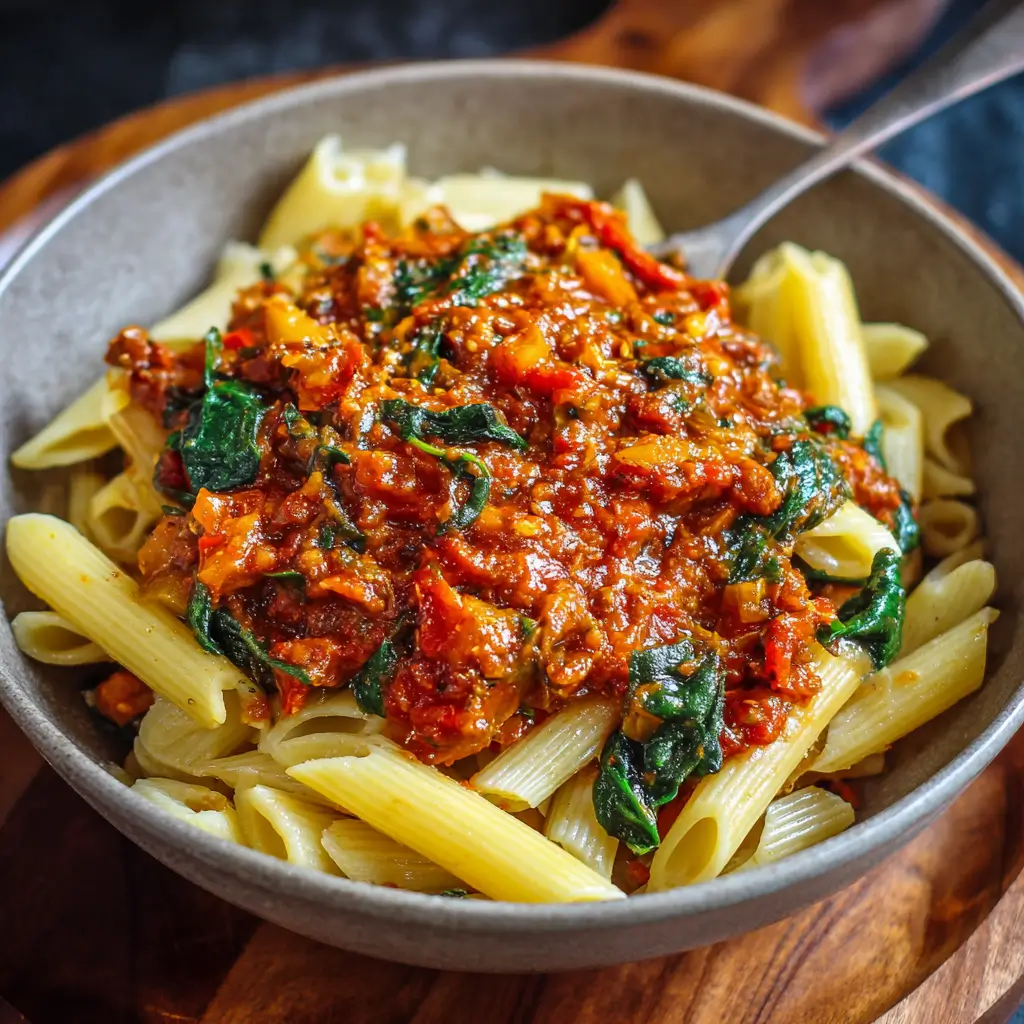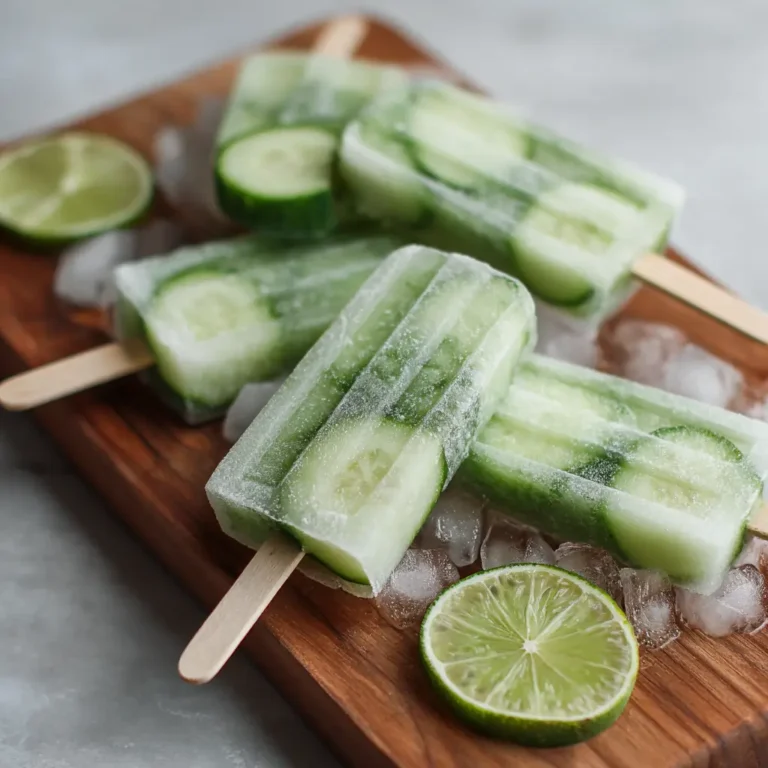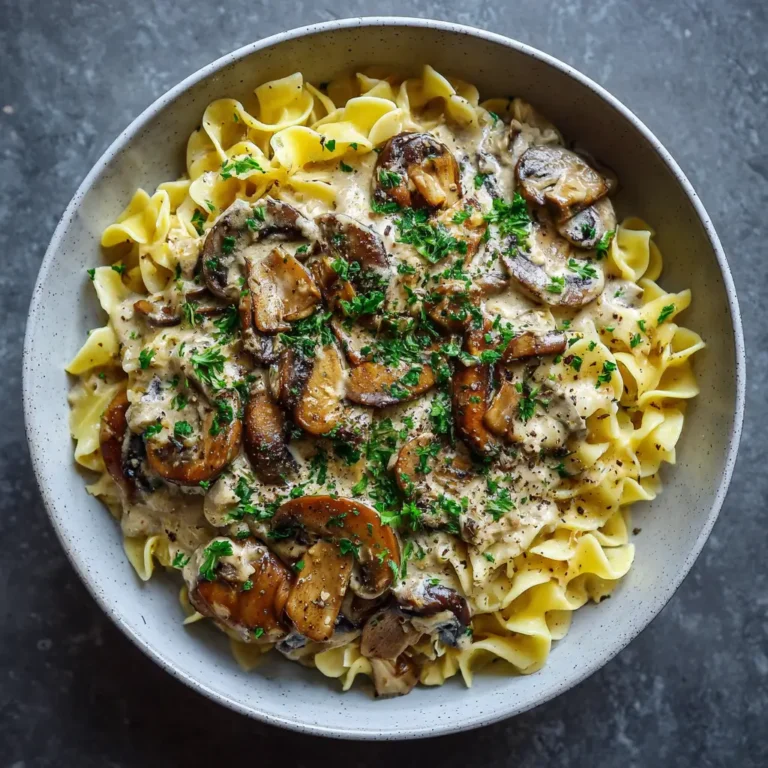Hidden Veggie Pasta Sauce
Introduction
Hidden Veggie Pasta Sauce is a delicious, nutritious, and clever way to sneak essential nutrients into meals—especially for picky eaters or families looking to boost their vegetable intake without sacrificing flavor. This rich, savory sauce blends the comforting taste of traditional tomato pasta sauce with a medley of finely blended vegetables that remain undetectable once mixed in. Whether you’re feeding children, health-conscious adults, or simply want a guilt-free meal upgrade, this sauce delivers on both nutrition and taste. With its vibrant color, smooth texture, and deep umami flavor, no one will guess just how many wholesome ingredients are hiding inside.
The History
The concept of “hiding” vegetables in food dates back centuries, but it gained modern popularity in the early 2000s as parents and health advocates searched for creative ways to increase vegetable consumption in diets dominated by processed foods. One of the most famous examples emerged from Dr. Jim Chapman’s research at Oxford Brookes University, where blending vegetables into sauces significantly increased fiber and nutrient intake without altering perceived taste. Around the same time, public figures like Jamie Oliver and initiatives such as the School Food Trust in the UK began promoting hidden veggie recipes in school lunches to combat childhood obesity. The idea quickly spread across North America and beyond, inspiring home cooks, chefs, and even food manufacturers to develop versions of stealth-veggie sauces. Today, Hidden Veggie Pasta Sauce has become a staple in health-focused kitchens and family meal planning, symbolizing a practical fusion of nutrition science and culinary creativity.
Ingredients Breakdown
The magic of this Hidden Veggie Pasta Sauce lies not only in its taste but also in the thoughtful selection and function of each ingredient. Every component plays a role in enhancing flavor, texture, or nutritional value:
- Tomatoes (canned crushed or pureed): The base of the sauce, providing acidity, sweetness, and lycopene—a powerful antioxidant linked to heart health and cancer prevention.
- Carrots: Finely grated or blended carrots add natural sweetness and beta-carotene, which converts to vitamin A in the body, supporting eye and immune health.
- Zucchini: Mild in flavor and high in water content, zucchini adds bulk and moisture while contributing potassium, vitamin C, and dietary fiber.
- Red Bell Peppers: These bring a subtle sweetness and vibrant color, along with high levels of vitamin C, vitamin B6, and antioxidants like capsanthin.
- Onions and Garlic: Sautéed until soft, they form the aromatic foundation, offering anti-inflammatory and immune-boosting properties due to their sulfur compounds.
- Spinach or Kale: Leafy greens blend seamlessly into the sauce, enriching it with iron, calcium, folate, and phytonutrients without altering the flavor.
- Mushrooms (cremini or white button): When puréed, mushrooms contribute an earthy umami depth and are rich in selenium and B vitamins.
- Olive Oil: Used for sautéing, it provides heart-healthy monounsaturated fats and helps absorb fat-soluble vitamins from the vegetables.
- Fresh Herbs (basil, oregano, thyme): These elevate the flavor profile and offer additional antioxidants and antimicrobial benefits.
- Optional Add-ins: Grated cauliflower, sweet potato, beets, or even cooked lentils can be incorporated for extra nutrients and thickness.
- Salt, Black Pepper, and Red Pepper Flakes: For seasoning and a touch of heat, balancing the natural sweetness of the vegetables.
- Balsamic Vinegar or Tomato Paste: Enhances richness and depth, adding complexity to the overall flavor.
Step-by-Step Recipe
- Prepare the Vegetables: Wash and roughly chop 1 medium onion, 2 cloves garlic, 2 medium carrots, 1 small zucchini, 1 red bell pepper, 4 oz mushrooms, and 2 cups fresh spinach or kale. Set aside.
- Sauté the Aromatics: In a large heavy-bottomed pot, heat 2 tablespoons of olive oil over medium heat. Add the chopped onion and cook for 5–7 minutes until translucent. Stir in the minced garlic and cook for another minute until fragrant.
- Add Hard Vegetables: Incorporate the carrots, red bell pepper, and mushrooms. Cook for 8–10 minutes, stirring occasionally, until softened and slightly caramelized.
- Incorporate Softer Veggies: Add the zucchini and continue cooking for another 5 minutes until all vegetables are tender.
- Blend the Mixture: Carefully transfer the cooked vegetables to a high-speed blender or food processor. Add 1 cup of canned crushed tomatoes and blend until completely smooth. (Alternatively, use an immersion blender directly in the pot for convenience.)
- Return to Pot: Pour the puréed mixture back into the pot. Stir in the remaining 2 cups of crushed tomatoes, 1 tablespoon tomato paste, ½ teaspoon dried oregano, ½ teaspoon dried basil, salt, and black pepper to taste.
- Simmer the Sauce: Bring the sauce to a gentle simmer over low heat. Allow it to cook uncovered for 30–45 minutes, stirring occasionally, to deepen the flavors and thicken the consistency.
- Add Greens: Stir in the fresh spinach or kale during the last 5 minutes of cooking, allowing them to wilt completely into the sauce.
- Final Adjustments: Taste and adjust seasoning. Add a splash of balsamic vinegar (about 1 tsp) for brightness, or a pinch of red pepper flakes for heat if desired.
- Use Immediately or Store: Serve over your favorite pasta, or let cool and store in airtight containers for later use.
Tips
- Blend Thoroughly: For a truly “hidden” effect, ensure the sauce is completely smooth. A high-powered blender works best to eliminate any fibrous textures.
- Cook Vegetables Until Soft: Properly sautéing the vegetables before blending enhances flavor and ensures a silky texture.
- Freeze in Portions: Pour cooled sauce into ice cube trays or small freezer-safe containers. This allows easy portioning when making single servings or adjusting recipe sizes.
- Boost Umami: Add a Parmesan rind while simmering, or stir in a teaspoon of miso paste for deeper savory notes.
- Thicken Naturally: If the sauce is too thin, extend the simmering time. Avoid flour or cornstarch unless necessary, as the vegetables naturally thicken the sauce.
- Use Quality Tomatoes: Opt for organic, no-salt-added crushed tomatoes to control sodium levels and avoid metallic aftertastes.
- Prep Ahead: Chop and store vegetables in advance for quicker weeknight preparation.
- Layer Flavors: Bloom dried herbs in oil before adding liquids to intensify their aroma and taste.
Variations and Customizations
This versatile sauce can be tailored to suit various dietary needs, flavor preferences, and seasonal produce:
- Creamy Version: Blend in ¼ cup of cashew cream, coconut milk, or Greek yogurt for a richer, velvety texture—ideal for fettuccine or lasagna.
- Spicy Kick: Add diced jalapeños, cayenne pepper, or harissa paste for those who enjoy heat.
- Meat-Enhanced: Brown ground turkey, lean beef, or plant-based crumbles and mix them into the sauce for added protein.
- Pumpkin or Sweet Potato Twist: Replace zucchini with roasted pumpkin or sweet potato for a subtly sweet, autumn-inspired variation rich in fiber and vitamin A.
- Roasted Vegetable Base: Roast carrots, peppers, onions, and tomatoes before blending for a smoky, concentrated flavor.
- Low-Acid Option: Use yellow tomatoes or add a pinch of baking soda to neutralize acidity for sensitive stomachs.
- Gluten-Free & Vegan: Naturally compliant, just ensure all packaged ingredients (like tomato products) are certified GF and free from animal derivatives.
- Kid-Friendly Fun: Mix in a spoonful of unsweetened applesauce or a grated apple to enhance sweetness without detection.
- Italian Herb Infusion: Steep a sprig of rosemary or a bay leaf during simmering, then remove before serving.
- Seafood Pairing: Lighten the sauce with extra basil and pair with shrimp or scallops for a gourmet twist.
Health Considerations and Nutritional Value
Hidden Veggie Pasta Sauce is a powerhouse of essential nutrients, making it an excellent addition to a balanced diet:
- Rich in Vitamins and Minerals: Packed with vitamins A (from carrots and greens), C (from bell peppers and tomatoes), K (from leafy greens), and potassium (from zucchini and tomatoes), this sauce supports immune function, vision, bone health, and blood pressure regulation.
- High in Fiber: The combination of vegetables contributes significant dietary fiber, promoting digestive health, satiety, and stable blood sugar levels.
- Antioxidant-Rich: Lycopene in tomatoes, beta-carotene in carrots, and flavonoids in onions and peppers help combat oxidative stress and reduce inflammation.
- Low in Added Sugars: Unlike many store-bought sauces, this homemade version relies on the natural sweetness of vegetables, avoiding refined sugars.
- Heart-Healthy Fats: Olive oil provides monounsaturated fats that support cardiovascular health.
- Supports Weight Management: High volume, low calorie density makes this sauce ideal for those managing weight while still enjoying satisfying meals.
- Dietary Flexibility: Easily adaptable for vegan, vegetarian, gluten-free, dairy-free, and low-sodium diets.
- Reduced Sodium Option: Control salt content by using no-salt-added tomatoes and limiting added salt—perfect for individuals with hypertension.
- Allergen-Friendly: Free from common allergens like nuts (unless using nut-based cream), soy (check tomato paste labels), and dairy (if kept vegan).
- Great for Kids’ Nutrition: Addresses common deficiencies in children’s diets by increasing vegetable intake without resistance.
Nutritional Estimate (per ½ cup serving): Approximately 60–80 calories, 2–3g protein, 8–10g carbohydrates, 3–4g fiber, 3–5g fat (mostly unsaturated), 200–300mg sodium (adjustable), and over 100% of daily vitamin A needs.
Ingredients
- 2 tablespoons olive oil
- 1 medium onion, chopped
- 2 garlic cloves, minced
- 2 medium carrots, peeled and chopped
- 1 small zucchini, chopped
- 1 red bell pepper, chopped
- 4 oz mushrooms (cremini or white), chopped
- 2 cups fresh spinach or kale, roughly chopped
- 3 cups canned crushed tomatoes (no salt added preferred)
- 1 tablespoon tomato paste
- ½ teaspoon dried oregano
- ½ teaspoon dried basil
- 1 teaspoon balsamic vinegar (optional)
- Salt and black pepper to taste
- Pinch of red pepper flakes (optional)
- 1 Parmesan rind (optional, omit for vegan)
Directions
- Heat olive oil in a large pot over medium heat. Add onion and sauté for 5–7 minutes until soft and translucent.
- Add minced garlic and cook for 1 minute until fragrant.
- Stir in carrots, red bell pepper, and mushrooms. Cook for 8–10 minutes, stirring occasionally, until vegetables begin to soften.
- Add zucchini and continue cooking for 5 more minutes.
- Transfer the cooked vegetables to a blender. Add 1 cup of crushed tomatoes and blend until completely smooth. (Use caution when blending hot liquids.)
- Return the puréed mixture to the pot. Stir in the remaining 2 cups of crushed tomatoes, tomato paste, oregano, basil, salt, pepper, red pepper flakes, and Parmesan rind (if using).
- Bring to a gentle simmer. Cook uncovered for 30–45 minutes, stirring occasionally, to develop flavor and thicken.
- Stir in spinach or kale during the last 5 minutes of cooking until wilted.
- Remove Parmesan rind if used. Stir in balsamic vinegar for brightness.
- Taste and adjust seasoning. Serve warm over whole grain, legume-based, or regular pasta. Garnish with fresh basil or nutritional yeast (for vegan option).
FAQ
Can I freeze Hidden Veggie Pasta Sauce?
Yes! This sauce freezes exceptionally well. Cool completely, then store in airtight containers or freezer bags for up to 6 months. Thaw overnight in the fridge or reheat from frozen on the stove.
Will my kids really not taste the vegetables?
Absolutely! When blended thoroughly and seasoned well, the vegetables become indistinguishable. Many parents report children loving the sauce without realizing it contains multiple veggies.
Can I make this in a slow cooker?
Yes. After sautéing the onions, garlic, and hard vegetables, transfer everything to a slow cooker. Add remaining ingredients and cook on low for 6–8 hours or high for 3–4 hours. Blend partially or fully before serving.
Is this sauce suitable for babies or toddlers?
Yes, it’s a fantastic way to introduce vegetables. Ensure the sauce is smooth and low in salt. You can dilute it slightly with water or broth for younger eaters.
Can I use frozen vegetables?
While fresh is best, you can use frozen carrots, spinach, or bell peppers in a pinch. Thaw and drain excess liquid before using to prevent a watery sauce.
How long does it keep in the refrigerator?
Stored in an airtight container, the sauce will stay fresh for 5–7 days.
Can I can this sauce for long-term shelf storage?
Yes, but follow proper canning guidelines. Process in a water bath for 35–40 minutes for pints, ensuring correct acidity levels (add lemon juice if needed).
What pasta pairs best with this sauce?
Works well with spaghetti, penne, rotini, or whole wheat noodles. Also great in lasagna, stuffed shells, or as a pizza base.
Can I make it chunkier?
Yes, if you prefer texture, reserve some sautéed vegetables before blending and stir them back in after.
Is this sauce oil-free?
Not by default, but you can sauté in vegetable broth instead of oil for an oil-free version.
Summary
Hidden Veggie Pasta Sauce is a nutritious, flavorful, and family-friendly way to increase vegetable intake without compromising on taste. Packed with wholesome ingredients and endless customization options, it’s a kitchen staple for healthy, delicious meals.






